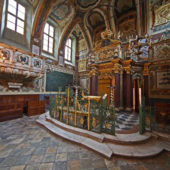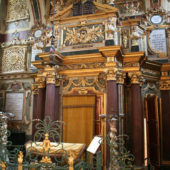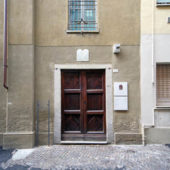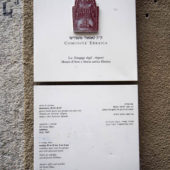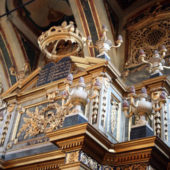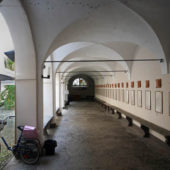One of the most exquisite remaining examples of Piedmontese Baroque architecture and ornamentation.
Casale Monferrato congregation began renting its current building on September 17, 1599. Early in 1606 a public oven for matzot was built close to the synagogue and thus began the history of the building that houses the Casale Monferrato synagogue. It fronts on a narrow lane of anonymous-looking homes. The synagogue building extends one entire block. It’s plain, anonymous facade blends in so well with the houses that from the street, it is virtually impossible to tell that it is a synagogue.
There was once a narrow lane, which led to a courtyard, with other twists and turns, eventually leading to a stairway, and then the hidden interior entrance to the synagogue. The entrance led to a hallway, into a cloister and from there to a rectangular prayer room. The Ark was situated along the Western wall, holding the Torah scrolls. Two rows of benches were laid out for the congregation, the men on one side and the women on the other; the women being hidden from the men by grates. This remained the layout of the synagogue until 1700, when another floor was added for the women. In 1787 the Ark was embellished with precious woods and gold leaf. At the same time a podium was carved from golden-hued wood. In 1853, further renovations took place to enlarge and improve the building and to adapt it for the community’s social needs. In 1866 the entrance to the Synagogue was moved to the middle of the western wall and some Venetian upgrades were made to the façade.
After years of decline, in 1968, the Synagogue was completely restored to its original Piedmontese Baroque splendor. Renovation took place under the direction of architect Giulio Bourbon, who now directs the Synagogue’s museum. Golden yellow, dark brown, pale green, and white are the primary colors used in the decorating, to complement dark wood pews and wood panels along the bottom half of the side walls. The Venetian mosaic floors lead up to the three-sided green and gildt wrought-iron gate in front of the bema. One’s eyes are drawn forward to the 18th century Ark, which is utterly magnificent, lavishly decorated in wood and gold. On either side of the Ark are three wood columns with Corinthian gilded capitals. The Ten Commandments are inscribed on tablets at the pinnacle of the Ark.
The Museum was architect Giulio Bourbon’s completion of the Casale Monferrato restoration. It houses one of the finest collections of Jewish ceremonial artifacts in Europe. The collection is comprised of silver ceremonial objects, embroideries, antique Torah scrolls, Torah breastplate, a crown and other ancient torah ornaments from the 17th century. Perhaps the world’s most unique and comprehensive collection of menorahs (eight branched candelabrum) as well as other ceremonial items are also on exhibit.
The 17th century, the Napoleonic era, was the heyday for the Jewish community of Casale Monferrato. There were 3000 Jews in the surrounding area; 1000 in Casale Monferrato itself. After World War II and the Holocaust only 120 Jews remained in Casale Monferrato; many had perished in concentration camps others had emigrated to Israel or moved to larger cities. Early in the 21st century only two Jewish families live in Casale. The tiny congregation has a council that meets regularly to plan activities and events. Jewish families living in nearby communities join Casale Monferrato for the High Holidays, although there is not a resident Rabbi. Casale Monferrato often organizes events to draw Jews from nearby towns so that they might keep the Jewish traditions alive.
In 1969, Casale Monferrato was officially recognized by the nation of Italy as a national treasure. Because it is such a magnificent example of Piedmontese Baroque architecture many Jewish and non-Jewish travelers visit Casale Monferrato Synagogue and its Museum.
Photographer’s Note: On our first visit to Casale Monferrato in 2006 to photograph the synagogue we met several of the 7 remaining members of the congregation. One lady, who I shall refer to as Mrs. O, told us stories about Casale and the Holocaust:
The synagogue also has a fantastic museum. In the museum, there is a leather Torah. “One day a cobbler came to visit the museum,” Mrs. O tells. “When he saw the Torah, he said, ‘Now I know what those little leather pieces with funny writing on them were that the Nazis gave me to make shoes in 1943-44.’”
In a room filled with rimmonim, one set was particularly lacy and beautiful. When I asked Mrs. O about it, she said that all the rimmonim except that one pair were collected from other synagogues. “When the Jews knew they would have to leave (during World War II), they had a brick wall built in the synagogue and hid all the silver, ritual objects, eternal lamps of which there were many and other items of religious significance behind it. After the Jews were taken away to the concentration camps, the bricklayer who had built the wall told the Germans about it. The Germans came and tore down the wall and stole all the treasures. But my father-in-law didn’t hide his with the others. He took them home. And they were the only ones saved.”

